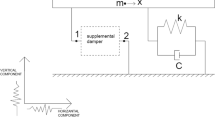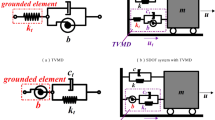Abstract
The series tuned inerter dampers (STID) with distributed inerters are proposed in this paper to suppress seismic response for ground motion excited structures with broadband characteristics. In order to reveal the mechanism of the STID for vibration mitigation, the dimensionless displacement objective function of a single degree of freedom structure equipped with an STID under random Gaussian white noise base excitations is thereupon derived. Based on the principle of the reasonable distribution of inertance, the analytical optimal design parameters of STID are obtained under constraint for total inerter-mass ratio. The vibration mitigation performance of the STID is evaluated and further compared with the tuned inerter damper (TID), tuned mass damper (TMD) and typical series dampers using same mass ratio or inerter-mass ratio when structure is subjected to harmonic and random excitation. Results demonstrate that the performance of structural vibration control and broadband characteristics of STID outperform both the TMD and TID. On the condition of same inerter-mass ratio, the deformation enhancement of damping element can be further increased compared with TID because of dual-tuning effect of series inerters. The higher vibration control performance of STID is realized by using very small nominal damping ratio compared with the TMD and TID. Meanwhile, there exist two grounded inerters in STID compared to other series dampers, and both two subsystems are not affected by base random acceleration excitation which also brings STID a wider VSB and better seismic response mitigation effect. Substantially, due to STID is a type of dual-grounded inerter-based device, for force and base acceleration excited main system, the optimal expressions are identical. Hence, STID can adapt to more complex practical engineering and random and diverse excitations. Hence, the STID can be deemed to be a broadband, high effectiveness and high-performance inerter system. Meanwhile, considering low damping, lightweight and flexible install of STID, it is easier for implementation in practical engineering.















Similar content being viewed by others
Data availability
No datasets were generated or analysed during the current study.
References
Lee, S.H., Min, K.W., Hwang, J.S., Kim, J.: Evaluation of equivalent damping ratio of a structure with added dampers. Eng. Struct. 26, 335–346 (2004)
Smith, M.C., Wang, F.C.: Performance benefits in passive vehicle suspensions employing inerters. Veh. Syst. Dyn. 42(4), 235–257 (2004)
Huong Quoc Cao: Combined tuned mass dampers for structural vibration control. Int. J. Non Linear Mech. 157, 104550 (2023)
Ikago, K., Saito, K., Inoue, N.: Seismic control of single-degree-of-freedom structure using tuned viscous mass damper. Earthq. Eng. Struct. Dyn. 41, 453–474 (2012)
Pan, C., Zhang, R., Luo, H., Li, C., Shen, H.: Demand-based optimal design of oscillator with parallel-layout viscous inerter damper. Struct. Control Health Monitor., 25(1), WOS:000417913100019 (2018)
Pan, C., Zhang, R.: Design of structure with inerter system based on stochastic response mitigation ratio. Struct. Control Health Monitor., 25(6), WOS:000432035200010 (2018)
Hwang, J.S., Kim, J., Kim, Y.M.: Rotational inertia dampers with toggle bracing for vibration control of a building structure. Eng. Struct. 29, 1201–1208 (2007)
Zhang, R.F., Zhao, Z.P., Dai, K.S.: Seismic response mitigation of a wind turbine tower using a tuned parallel inerter mass system. Eng. Struct. 180, 29–39 (2019)
Zhao, Z.P., Zhang, R.F., Wierschem, N.E., Jiang, Y.Y., Pan, C.: Displacement mitigationoriented design and mechanism for inerter-based isolation system. J Vib Control (2020)
De Domenico, D., Ricciardi, G.: An enhanced base isolation system equipped with optimal tuned mass damper inerter (TMDI). Earthq. Eng. Struct. Dyn. 47(5), 1–192 (2018)s
De Domenico, D., Impollonia, N., Ricciardi, G.: Soil-dependent optimum design of a new passive vibration control system combining seismic base isolation with tuned inerter damper. Soil Dyn. Earthq. Eng. 105 , 37e53 (2018)
De Domenico, D., Ricciardi, G.: Optimal design and seismic performance of tuned mass damper inerter (TMDI) for structures with nonlinear base isolation systems. Earthq. Eng. Struct. Dyn. 47(12) , 2539e2560 (2018)
Zhao, Z.P., Zhang, R.F., Jiang, Y.Y., Pan, C.: Seismic response mitigation of structures with a friction pendulum inerter system. Eng. Struct. 193, 110–120 (2019)
Nakamura, Y., Fukukita, A., Tamura, K., Yamazaki, I., Matsuoka, T., Hiramoto, K., Sunakoda, K.: Seismic response control using electromagnetic inerter-mass dampers. Earthq. Eng. Struct. Dyn. 43(4), 507e527 (2014). https://doi.org/10.1002/eqe.2355.
Wang, F.C., Chen, C.W., Liao, M.K., Hong, M.F.: Performance analyses of building suspension control with inerters. In: 2007 IEEE Conference on Decision and Control, pp. 3786e3791 (2007)
Lazar, I.F., Wagg, D.J., Neild, S.A.: An inerter vibration isolation system for the control of seismically excited structures. In: International Conference on Urban Earthquake Engineering. Tokyo, Japan (2013)
Luo, H., Zhang, R.F., Weng, D.G.: Mitigation of liquid sloshing in storage tanks by using a hybrid control method. Soil Dyn. Earthq. Eng. 90, 183–195 (2016)
Marian, L., Giaralis, A.: Optimal design of a novel tuned mass-dampereinerter (TMDI) passive vibration control configuration for stochastically support-excited structural systems. Probabilist. Eng. Mech. 38 , 156e164 (2014)
Hashimoto, T., Fujita, K., Tsuji, M., Takewaki, I.: Innovative base-isolated building with large mass-ratio TMD at basement for greater earthquake resilience. Future Cities Environ. 1(1), 9 (2015)
Pietrosanti, D., Angelis, M.D., Basili, M.: Optimal design and performance evaluation of systems with tuned mass damper inerter (TMDI). Earthq. Eng.Struct. Dyn. 46(8) , 1367e1388 (2017)
Araz, O., Elias, S., Kablan, F.: Seismic-induced vibration control of a multi-story building with double tuned mass dampers considering soil-structure interaction. Soil Dyn. Earthq. Eng., 166, 107765 (2023)
Araz, O.: Optimization of three-element tuned mass damper based on minimization of the acceleration transfer function for seismically excited structures. J. Braz. Soc. Mech. Sci. Eng. 44, 459 (2022)
Araz, O., Farsangi, E.N.: Optimum tuned tandem mass dampers for suppressing seismic-induced vibrations considering soil-structure interaction. Structures 52, 1146–1159 (2023)
Araz, O., Ozturk, K.F., Cakir, T.: Effect of different objective functions on control performance of tuned mass damper for a high-rise building considering soil–structure interaction. Arch. Appl. Mech. 92, 1413–1429 (2022)
Araz, O., Cakir, T., Ozturk, K.F.: Effect of earthquake frequency content on seismic-induced vibration control of structures equipped with tuned mass damper. J. Braz. Soc. Mech. Sci. Eng. 44, 584 (2022)
Araz, O., Cakir, T., Ozturk, K.F., Kaya, D.: Effect of foundation embedment ratio in suppressing seismic-induced vibrations using optimum tuned mass damper. Soil Dyn. Earthq. Eng. 171, 107981 (2023)
Araz, O., Kahya, V.: Design of series tuned mass dampers for seismic control of structures using simulated annealing algorithm. Arch. Appl. Mech. 91, 4343–4359 (2021)
Araz, O.: Optimization of tuned mass damper inerter for a high-rise building considering soil-structure interaction. Arch. Appl. Mech. 92, 2951–2971 (2022)
Cao, L., Li, C., Chen, X.: Performance of multiple tuned mass dampers-inerters for structures under harmonic ground acceleration. Smart Struct. Syst. 26(1), 49–61 (2020)
Cao, L., Li, C.: Tuned tandem mass dampers-inerters with broadband high effectiveness for structures under white noise base excitations. Struct. Control. Health Monit. 26, e2319 (2019)
Cao, L., Li, C.: Enhanced hybrid active tuned mass dampers for structures. Struct. Control. Health Monit. 25, e2067 (2018)
Asami, T.: Optimal design of double-mass dynamic vibration absorbers arranged in series or in parallel. J. Vib. Acoust. 139, 011015 (2016)
Roberts, J.B.: Random Vibration and Statistical Linearization, Wiley (1990)
Zhang, R., Huang, J., Zhang, Y.: Analytical optimal design of inerter system for seismic protection using grounded element. Arch. Appl. Mech. (2023)
Barredo, E., Larios, J.G.M., Mayén, J., Flores-Hernández, A.A., Colín, J., Montiel, M.A.: Optimal design for high-performance passive dynamic vibration absorbers under random vibration. Eng. Struct. 195, 469–489 (2019)
Eduardo Barredo, J.G., Larios, M., Colín, J., Mayén, J., Flores-Hernández, A.A., Arias-Montiel, M.: A novel high-performance passive non-traditional inerter-based dynamic vibration absorber. J. Sound Vib. 485, 115583 (2020)
Acknowledgements
This work was financially supported by Science and Technology Major Special Program Project of Shanxi Province (Grant no. 202201150501024) and Funding for Zhejiang Electric Power Industry Corporation (CF058807002021006).
Author information
Authors and Affiliations
Contributions
RY.Z helped in methodology, conceptualization, software, investigation, writing—original draft and writing—review & editing; JZ.H worked in supervision, funding acquisition, investigation, conceptualization, validation and writing—review & editing and MG.C worked in funding acquisition, conceptualization, methodology, investigation, validation and writing—review & editing.
Corresponding author
Ethics declarations
Conflict of interest
The authors declare that there is no conflict of interest regarding the publication of this paper.
Additional information
Publisher's Note
Springer Nature remains neutral with regard to jurisdictional claims in published maps and institutional affiliations.
Rights and permissions
Springer Nature or its licensor (e.g. a society or other partner) holds exclusive rights to this article under a publishing agreement with the author(s) or other rightsholder(s); author self-archiving of the accepted manuscript version of this article is solely governed by the terms of such publishing agreement and applicable law.
About this article
Cite this article
Zhang, R., Huang, J. & Cao, M. Analytical optimal design and performance evaluation of series tuned inerter damper for ground motion excited structures. Arch Appl Mech 94, 1739–1752 (2024). https://doi.org/10.1007/s00419-024-02599-1
Received:
Accepted:
Published:
Issue Date:
DOI: https://doi.org/10.1007/s00419-024-02599-1




